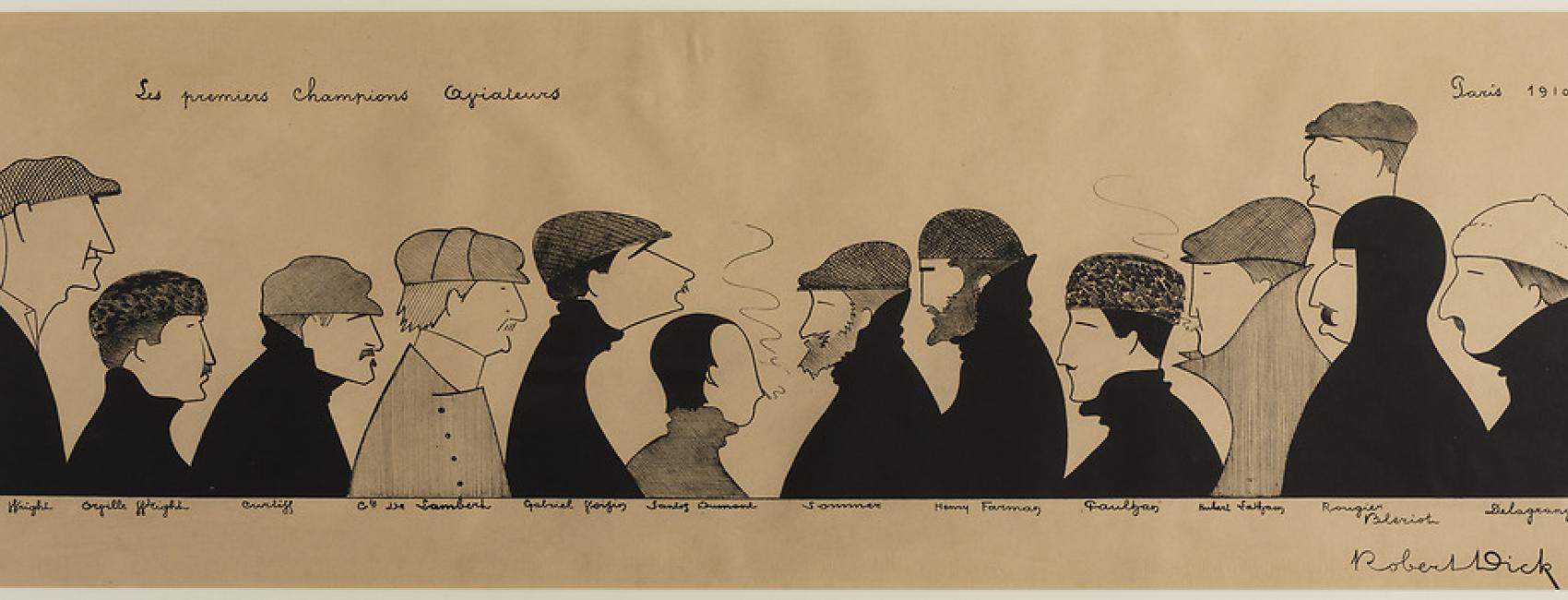
The Wright brothers’ invention of the airplane truly changed the world.
Imagining what this new world would be like began as soon as the first airplanes took to the air in the early 1900s.
With the growing public fascination with all things flight related, the airplane soon became part of culture. Airplanes and flight themes began to appear on jewelry, games, in cartoons and illustrations, in art and literature, and more. Yet another sign that the aerial age had begun. Take a look at some of these aviation-inspired items below.
This Gilbert Erector Set featured Wright and Blériot airplanes as project that could be built.
Front cover of the manual for the 1913 Mysto Manufacturing Company "The Erector" set produced by A. C. Gilbert, New Haven, Connecticut. It reads: "The Erector: Structural Steel & Electro Mechanical Builder; Educational, Instructive, and Amusing."
This ca.1910 pillbox depicts an Antoinette monoplane.
This pillbox features a Blériot monoplane on its lid.
L'Assiette au Beurre (The Plate with Butter) was a weekly magazine of social satire published from 1901 to 1914. Each issue was devoted entirely to one subject.
Les Aéroplanes, 1908
In 1908, L'Assiette au Buerre published an issue on airplanes was illustrated by noted Spanish artist Juan Gris, one of the leading exponents of Cubist painting, and Jules Grandjouan, a pioneer political illustrator.
Aéro-Modes Pour 1910
(Extrait du Catalogue d' "Antoinette Soeurs")
A Satirical drawing by Verjez from an unknown French periodical (possiblyLe Sourire) depicting women modeling "Aero-Fashions for 1910" from the "Antoinette Sisters" catalogue. The woman with a biplane-shaped hat at right says "Your monoplane is ravishing, my dear!," and the woman at left wearing a monoplane-inspired hat replies, "Yes, but the biplane is more becoming." The first woman replies, "And for stability, there's nothing like a Wright!"
Le Départ d'un Transatlantique en 1960
A humorous drawing reprinted as "Le Départ d'un Transatlantique en 1960" ["Transatlantic Departure in 1960"] in French periodical Le Sourire (Paris, France). The cartoon originally appeared in Life magazine on January 6, 1910, with the caption "Bon Voyage." The cartoon illustration depicts an ocean-liner-sized airship docked at a rooftop departure platform labeled "United Air Line: London and Paris."

Enthusiasm for flight was also expressed musically. The romance of flying and the appeal of the dashing, daring aviator were natural themes for popular song. Like other artists, musical composers found the aerial age rich inspiration for their creativity. In addition to the entertaining tunes, the sheet music of the period was visually striking.
The airplane appeared just as Cubism and the modern art movement emerged. The forward-looking nature of human flight was fertile subject matter for these abstract expressionist pioneers. Pablo Picasso, Henri Rousseau, Kazimir Malevich, Giacomo Balla, and Robert Delaunay produced works inspired by and featuring the airplane. The Italian Futurists were especially influential in motivating these avant-garde artists to explore aviation.
Eiffel Tower and Gardens, Champ de Mars (La Tour Eiffel et Jardin du Champ de Mars)
Robert Delaunay, Oil on canvas, 1922
70 1/8 x 67 1/8 in. (178.1 x 170.4 cm)
The Joseph H. Hirshhorn Bequest, 1981
Before the invention of the airplane only birds or people in balloons would have had this view. The airplane changed the perspective of artists and how we viewed the world—as is seen here in Robert Delaunay's 1922 painting Eiffel Tower and the Gardens, Champs de Mars.
Malevich and Delaunay in particular were taken with aviation. For them, flight was a metaphor for the transformation of consciousness, a liberation from the constraints of normal existence, and a redefinition of time and space. They had a passion for the new 20th-century technologies and were fascinated with the notion of escape from the earth.
The avant-garde were not the only artists who pursued aviation themes. The airplane appeared in poster art, landscapes, caricature, photography, and representational works as well.
A lithograph by Robert Dick entitled Les Primiers Champions Aviateurs which features caricatures of early fliers.
View Les Premiers Champions Aviateurs Lithograph
A lithograph by French artist Marguerite Montaut entitled Garros Gagne le Grand Prix de l'aero club, 1912 which translates to: Garros Wins the Aero Club Grand Prix, 1912.
View Garros Gagne le Grand Prix Lithograph